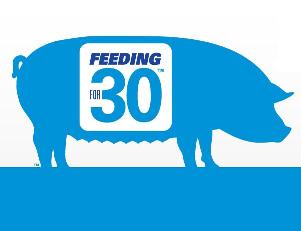Land O’Lakes Purina Feed’s sow nutrition forum highlighted at World Pork Expo

Land O’Lakes Purina Feed in conjunction with Zinpro’s Feeding for 30 Program during the World Pork Expo in Des Moines, Iowa was the occasion for much involved discussion on shared research and management strategies sow nutrtion.
Land O’Lakes Purina Feed LLC hosted the Feeding for 30 Sow Nutrition Forum on June 6. Industry experts and producers who are working to achieve the goal of 30 pigs per sow per year formed the panel that presented to a standing room only audience.
“The goal of increased efficiency through effective management was consistent among all of the panelists,” says Elena Lindemann, lactating livestock marketing director with Land O’Lakes Purina Feed LLC. “Producers, veterinarians and industry members from across the world heard how the six panelists have worked toward achieving 30 pigs per sow per year. The consensus among the group was that sow nutrition is vital to long-term herd performance.”
Producer panelists included: Mike Cronin, owner of Oak Grove Pork based in Ontario, Canada; Mike Deahr, owner of Pork 360 in West Liberty, Iowa; and Dave Hansen, owner of Hansen Hog West in Harlington, Neb. The three producers agreed that sow nutrition is essential in the success of their farrow-to-finish operations.
“A focus on what we’re feeding during farrowing has decreased the number of days to rebreeding, increased feed efficiency and improved birthweights on our operation,” Hansen said. “Nutrition’s helped us move closer to 30 pigs per sow per year.”
Industry panelists who joined the producers included: Dr. Gawain Willis, director of nutritional services with Land O’Lakes Purina Feed LLC; Ron Ketcham, consultant with Swine Management Services, LLC; and Steve Kruse, east production director with Pipestone System.
Willis shared research on sow nutrition collected at the LongView Animal Nutrition Center in Gray Summit, Mo. that correlates with Hansen’s experiences. On 2,456 litters recorded over a period of six years, pigs with birthweights between 2.1 and 2.5 had preweaning mortality rates twice as high as pigs with measured birthweights between 3.1 and 3.5 pounds. Along with proper sow nutrition to reach higher birthweights, Willis emphasized the importance of monitoring performance through the production chain.
“There is a lot of power in setting benchmarks and following through with goals,” he said. “As an industry, we need to improve production efficiency if we’re going to stay in business. Improvement begins by evaluating our operations and working towards improvement.
“Many of the goals we set, whether they include colostrum quality, birth weights, growth rates or return to estrus, come back to sow nutrition,” Willis added. “Nutrition must support genetics. When the two come together, the economics are obvious. One extra pig can directly add to the profit side, so meeting the goal of 30 pigs per sow per year can have significant economic potential and herd health benefits.”
Swine producers, veterinarians and nutritionists can learn more by go to Feeding for 30 Program.











